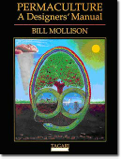Permaculture also aims to stop interrupting nature's succession as conventional farming and gardening do by switching the emphasis from annual plants to perennial herbaceous plants, shrubs and trees. One can joyfully spend a lifetime studying and growing perennial plants and guilds. See our perennial vegetables seeds.
Ethics are at the center of permaculture: care for the earth, care for people and share the surplus. From there a series of principles radiate out such as stacking functions, the output of one element should be the input of another element or capture and store energy. Design spaces are prioritized by dividing them into zones of proximity and sectors of energy entering the system. Permaculture is unique as a design system.
Is Forest Gardening Permaculture?
No. Forest gardening is just one element of permaculture and it is sometimes mistakenly called permaculture. Permaculture is a design system developed by Bill Mollison and David Holmgren in the 1970s. Originally meaning permanent culture it has broadened to permanent culture. Permaculture encompasses all aspects of sustainable living, including food cultivation, building design, energy systems, community structure and even legal systems. This course focuses on the element of forest garden design.
The Permaculture Design Certificate (PDC) course
The Permaculture Design Course was created by Bill Mollison in the 1970s as a way to teach and spread permaculture. A good permaculture design course is held on a working permaculture farm or homestead. Each day should be balanced between classroom and hands-on activities.
The PDC course is typically taught over two weeks or on six weekends. The two week course is called a residential course because students live onsite for two weeks. Avoid courses the cut that time short and teach over ten days or five weeks; they will may burnout with teaching in the evenings or omit part of the curriculum.
 Curriculum
Curriculum
To receive a valid design certificate a minimum of 72 hours of instruction must be given as outlined by Bill Mollison's book, Permaculture: A Designer’s Manual. The curriculum may be taught in any order. Courses should also include a group design project to give students real-world design experience. Typical PDC curriculum:
~ Meta Systems ~
Day 2: Chapter 2: Concepts and Themes in Design. Chapter 3: Methods of Design. Ground Planning.
Day 3: Chapter 4: Pattern Understanding.
Day 4: Urban/Suburban Permaculture. Design Client Relationship. Visit group design sites.
~ Natural Systems ~
Day 5: Chapter 6: Trees and Their Energy Transactions. Pruning and Grafting workshop.
Day 6: Chapter 5: Climatic Factors.
Day 7: Chapter 8: soils.
Day off.
~ Cultivated Systems ~
Day 8: Chapter 7: Water
Day 9: Chapter 12: Humid Cool to Cold Climates. Chapter 9: Earth Working and Earth Resources.
Day 10: Chapter 10: The Humid Tropics; Chapter 11: Drylands Strategies. Activity group design work.
Day 11: Chapter 13: Aquaculture. Garden Cooking and Preserving the Harvest. Activity group design work.
Day 12: Chapter 14: The Strategies of an Alternative Global Nation. Activity group design project and PDC fiesta.
Day 13: Design Presentations. Certificates. Student intention affirmation, photos and goodbyes. Finished after lunch.
Certification: Apprentice Designer
PDC certificate holders are considered apprentice designers until they have had three years of permaculture design experience, after which they become a full designer. Designers gain experience at existing permaculture sites, institutes, work-trade, internships and by designing, installing and maintaining their own backyard permaculture site; trial and error are excellent teachers. Career designers may may take an advanced Edible Forest Garden Design, Natural Building, Surveying or Social Forestry courses.
You can take Permaculture Design Certificate (PDC) course at Restoration Farm from the Southern Oregon Permaculture Institute.
---
© 2013–2018 Restoration Seeds, LLC
